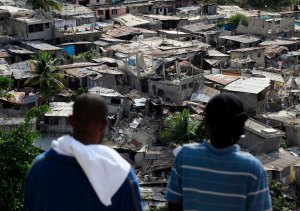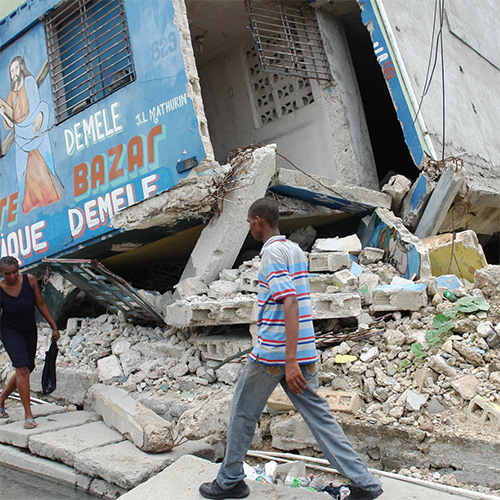Haiti Ten Years after the Earthquake
LATIN AMERICA AND THE CARIBBEAN, 17 Feb 2020
Resumen | Haiti Action Committee – TRANSCEND Media Service
10 Feb 2020 – January 12 marked 10 years since the 2010 earthquake in Haiti that killed more than 300,000 people and left an estimated 1.3 million more homeless. Much of the greater Port-au-Prince region laid in ruins, including the presidential palace, 17 of 19 ministries, and many schools and hospitals. Entire neighborhoods leveled, power outages, roads blocked with rubble, some still not removed.
Generous people worldwide, including half of all registered voters in the United States, donated $3 billion to NGOs, as part of the total of $16.3 billion spent or promised for earthquake relief, but most of this money never reached Haitians on the ground. Also, figures vary by source, and we really don’t know a lot about where much of the money went. By the end of 2018, $7.54 billion had been dispersed by donors, with little to no accountability for how or where it was spent, much of it on projects that did not directly benefit Haiti or Haitians. Many countries never gave what they promised. Of the money pledged, $972M was for debt relief – money Haiti never had in the first place. NGOs used much of their $3 billion for overhead (spent in the countries where they are based) or left money unspent. The American Red Cross received $486 million, took out 25% for its own internal expenses, built 6 houses, and used some of what was donated for Haiti in other countries. The Clinton Bush Fund spent $2 million building a luxury hotel for business travelers. The biggest investment went into the Caracol Industrial Park, more than 130 miles from Port-au-Prince, which today provides only a fraction of the sweatshop jobs promised.
The United States government militarized the emergency aid. They sent in thousands of troops to provide “security,” when Haitians needed food, water, and medical care. There had been no security crisis at all. Even U.S. general noted things were “relatively calm.” The airport was so clogged unloading military personnel and supplies, that Doctors Without Borders said that five of its cargo flights carrying 85 tons of medical and relief supplies were turned away and had to be shipped into Haiti by ground from the Dominican Republic. Flights from the World Food Program were delayed up to two days.
In the meantime, Haitians were taking matters into their own hands, organizing themselves into popular committees to clean up, to pull bodies from the rubble, build refugee camps, and provide for security. Grassroots women’s organizations that permeate Haitian communities mobilized to contend with the collective loss of already vulnerable housing, water, food, and livelihoods. Many of these resourceful organizers belonged to the Lavalas movement of President Jean-Bertrand Aristide, twice elected by huge majorities, but overthrown by military coups in 1991 and 2004, and this is what the United States government and the Haitian elites feared the most. Instead of distributing emergency supplies to those who could deliver them most effectively, the thrust of militarized “relief” was to prevent supplies from reaching those who could help the most, out of a distrust of Haitians, the dismissal of their ability to rebuild and direct their own reconstruction, and the fear they might actually succeed. And in case any mass demonstrations developed in the streets, U.S. and U.N. occupation troops were there to put them down.
The United States pledged $940M by the end of September 2010, but almost half, $465 million, went through the Defense Department as reimbursement for their expenses. Of $2.43 billion in donations that came in by the end of 2010, at least 93% went back to the UN or NGOs to pay for supplies and personnel or never left the donor states at all. $151 million was completely unaccounted for. Only 1% – $24 million went to the Haitian government.
The United States seized on the earthquake as a pretext to reinforce its neoliberal economic agenda on Haiti. And the Haitian earthquake proved to be highly lucrative to foreign businesses. In the private sector, of nearly $1 billion spent in US government contracts for post quake Haiti by April 2011, only 23 of 1490 contracts went to Haitian firms for a total of $4.8 million. Through 2018 the US Agency for International Development (USAID) awarded $2.3 billion, but only 2.3% of it went directly to Haitian organizations or companies. A Haitian official commented, “We are the ones accused of corruption for the money we don’t receive.”
In spite of all efforts to marginalize them, the Haitian grassroots movement has only grown stronger in the ten years since the quake. Their advocacy led to the return of President Aristide from exile in South Africa in 2011, but all they could do to stop the imposition of Michel Martelly as president was to not vote. Aristide’s Fanmi Lavalas Party was still banned from participating in elections because it was understood they would win. Despite the record low turnout, the world powers recognized Martelly, who began his administration of repression, theft, corruption, and the selling off of Haitian land and resources.
Upon his return, Aristide and his wife and colleague, Mildred Trouillot Aristide, reopened the University of the Aristide Foundation (UNIFA), which has now graduated its second class. UNIFA has Schools of Medicine, Nursing, Physical Therapy, Engineering, Dentistry, Law and Continuing Education, and is raising funds to build a teaching hospital. Radio and Tele Timoun operate from the Aristide Foundation and provide news to counter the monopoly news corporations.
But the United States, the United Nations, and the Haitian elites still fear the popular movement and have turned to increasingly brutal tactics to suppress it. In a completely corrupt election cycle in 2015/2016, Fanmi Lavalas was allowed to run candidates, but they were prevented from winning through massive voter suppression and fraud. The electoral council named a completely unqualified Jovenel Moise president, stopping a recount in mid-process. Haitians have been in the streets ever since in protest.
Now it’s been discovered that $4.2 billion has disappeared from Petrocaribe funds. Venezuela has been selling Haiti oil at discounted prices through its Petrocaribe program, initiated by the government of Hugo Chavez, with the understanding that Haiti will sell the oil at market rate and use the profit to finance infrastructure and economic development. Instead, the Martelly and Moise regimes have stolen it, and the protests have only grown stronger calling on the imposed president Moise to resign.
Instead, Moise has dug in and is refusing to leave. Police, under the control of the United Nations, and death squads reminiscent of the tonton macoutes of the Duvalier dictatorships operate with impunity. In November 2018, they massacred at least 77 people and possibly many more whose bodies were not found, in the historically militant neighborhood of La Saline. They attack demonstrations, and on June 24, 2019, fired into a crowd of protesters, killing as many as 30 people. Moise is now hiring foreign mercenaries as well to control and terrorize the population.
Haiti needs massive solidarity to support the grassroots movement calling for the overthrow of the Moise regime, and the creation of a society based on democracy and economic equality. There is almost no informed media coverage of Haiti now. Haiti Action Committee is working to Make Haiti Visible and to support the Haiti Emergency Relief Fund – www.haitiemergencyrelief.org, which will get donations to the people on the ground doing the work to fulfill the dream of the 1804 revolution that has been suppressed ever since. Please join with us.
Go to Original – resumen-english.org
Tags: Conflict, Corruption, Democracy, Geopolitics, Haiti, Hegemony, Human Rights, Imperialism, International Relations, Latin America Caribbean, Military Intervention, Neocolonialism, US Military, USA
DISCLAIMER: The statements, views and opinions expressed in pieces republished here are solely those of the authors and do not necessarily represent those of TMS. In accordance with title 17 U.S.C. section 107, this material is distributed without profit to those who have expressed a prior interest in receiving the included information for research and educational purposes. TMS has no affiliation whatsoever with the originator of this article nor is TMS endorsed or sponsored by the originator. “GO TO ORIGINAL” links are provided as a convenience to our readers and allow for verification of authenticity. However, as originating pages are often updated by their originating host sites, the versions posted may not match the versions our readers view when clicking the “GO TO ORIGINAL” links. This site contains copyrighted material the use of which has not always been specifically authorized by the copyright owner. We are making such material available in our efforts to advance understanding of environmental, political, human rights, economic, democracy, scientific, and social justice issues, etc. We believe this constitutes a ‘fair use’ of any such copyrighted material as provided for in section 107 of the US Copyright Law. In accordance with Title 17 U.S.C. Section 107, the material on this site is distributed without profit to those who have expressed a prior interest in receiving the included information for research and educational purposes. For more information go to: http://www.law.cornell.edu/uscode/17/107.shtml. If you wish to use copyrighted material from this site for purposes of your own that go beyond ‘fair use’, you must obtain permission from the copyright owner.
One Response to “Haiti Ten Years after the Earthquake”
Read more
Click here to go to the current weekly digest or pick another article:
LATIN AMERICA AND THE CARIBBEAN:


[…] lavorando per Rendere Visibile Haiti e sostenere il Fondo di soccorso d’Emergenza di Haiti – http://www.haitiemergencyrelief.org passerà le donazioni alla gente sul terreno compiendo il lavoro di adempiere al sogno della […]